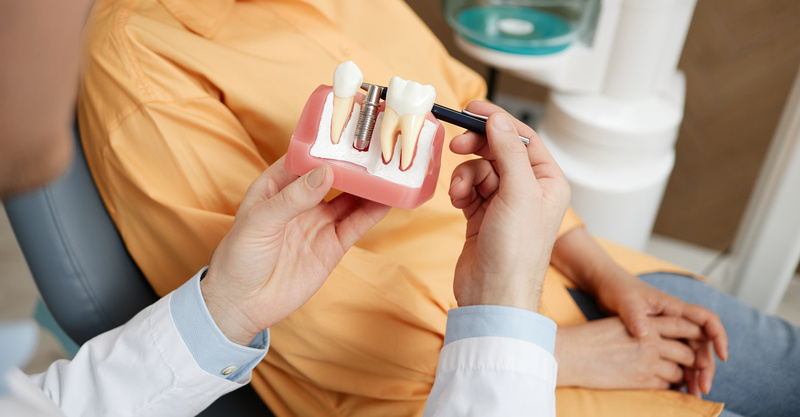Key Points
- Dental plaque, a sticky film of bacteria, food particles, and saliva, can lead to serious dental issues like cavities and gum disease if not properly managed.
- Plaque feeds on sugars and can erode tooth enamel, hardening into tartar if not regularly removed, which can only be removed by a dental professional.
- Several factors contribute to plaque formation including high-sugar diets, poor oral hygiene, reduced saliva flow, and smoking.
- Symptoms of dental plaque include red, swollen gums, persistent bad breath, tooth sensitivity, visible plaque deposits, tooth discoloration, and gum recession.
- The article provides 15 tips for preventing plaque, such as regular brushing and flossing, using an antibacterial mouthwash, regular dental visits, a balanced diet, staying hydrated, avoiding tobacco, and chewing sugar-free gum.
Dental plaque is a sticky, colorless film of bacteria that constantly forms on our teeth, according to the Academy of General Dentistry. They explain that removing dental plaque is crucial for maintaining oral health, as its buildup can lead to cavities, gum disease, and other serious dental issues. By understanding the nature of plaque and how to effectively manage it, you can take proactive steps to ensure a healthy and bright smile.
Read on to learn more about what dental plaque is, why it's important to remove it, and the best methods for doing so.
Dental Plaque 101
Dental plaque is a soft, sticky film that accumulates on the surfaces of your teeth, particularly along the gumline, according to the American Association of Orthodontists (AAO). They explain that it is composed of a mixture of bacteria, food particles, and saliva. The bacteria in dental plaque feed on sugars from the food and drinks you consume, producing acids that can erode tooth enamel and lead to cavities.
Visually, dental plaque is often colorless or pale yellow, making it difficult to see with the naked eye, according to the AAO. However, it can sometimes feel like a fuzzy coating on your teeth, especially if you haven't brushed in a while. If plaque is not removed regularly through proper oral hygiene practices, it can harden into tartar (also known as calculus), which is a yellow or brown deposit that can only be removed by a dental professional.
Causes of Dental Plaque
Dental plaque is primarily caused by the accumulation of bacteria in the mouth, according to the American Dental Association (ADA). These bacteria thrive on the sugars and starches found in the food and beverages we consume.
Some of the key factors that contribute to the formation of dental plaque:
-
Diet: Foods and drinks high in sugars and carbohydrates provide an ideal environment for bacteria to thrive. When these bacteria feed on sugars, they produce acids that can harm tooth enamel.
-
Poor Oral Hygiene: Inadequate brushing and flossing allow plaque to build up on the teeth and along the gumline. Without regular removal, plaque can harden into tartar, making it even more difficult to eliminate.
-
Saliva: Saliva helps wash away food particles and neutralize acids produced by bacteria. However, if the flow of saliva is reduced (due to dehydration, certain medications, or medical conditions), plaque can accumulate more easily.
-
Bacteria: The human mouth contains hundreds of different types of bacteria. While some are beneficial, others contribute to plaque formation. The balance of these bacteria can be influenced by diet, oral hygiene, and overall health.
-
pH Levels: The acidity of the mouth can affect plaque formation. Foods and drinks that lower the pH level in the mouth (making it more acidic) can promote the growth of harmful bacteria and plaque buildup.
-
Smoking and Tobacco Use: Tobacco products can contribute to the buildup of plaque and tartar, as well as reduce saliva flow and harm the gums.
By understanding these factors, you can take proactive steps to minimize plaque formation through proper diet, regular oral hygiene, and healthy lifestyle choices.
Dental Plaque vs Tartar
Dental plaque and tartar are related but distinct substances that can affect oral health. Here's a breakdown of their differences, as outlined by the ADA:
Dental Plaque:
-
Nature: Dental plaque is a soft, sticky film that forms on the teeth and gumline. It is primarily composed of bacteria, food particles, and saliva.
-
Formation: Plaque forms continuously on the teeth, especially after eating or drinking sugary or starchy foods.
-
Appearance: Plaque is usually colorless or pale yellow, making it difficult to see with the naked eye. It can feel like a fuzzy coating on the teeth.
-
Removal: Plaque can be removed through regular oral hygiene practices, such as brushing twice a day, flossing daily, and using mouthwash.
-
Health Impact: If not removed, plaque can lead to tooth decay, gum inflammation (gingivitis), and other oral health issues.
Tartar:
-
Nature: Tartar, also known as calculus, is hardened dental plaque. It forms when plaque is not removed and mineralizes over time.
-
Formation: Tartar develops when plaque remains on the teeth for an extended period, typically a few days to weeks. The minerals in saliva combine with plaque, causing it to harden.
-
Appearance: Tartar is more visible than plaque and appears as a yellow or brown deposit on the teeth, particularly around the gumline.
-
Removal: Unlike plaque, tartar cannot be removed by regular brushing and flossing. It requires professional cleaning by a dentist or dental hygienist using specialized tools.
-
Health Impact: Tartar buildup can contribute to more severe oral health problems, such as advanced gum disease (periodontitis), cavities, and bad breath. It also makes it more difficult to remove new plaque and can lead to further dental complications.
In summary, while dental plaque is a soft, removable film that forms on teeth, tartar is its hardened form that requires professional intervention. Both can negatively affect oral health, making it essential to maintain good oral hygiene practices to prevent their buildup.
Dental Plaque Symptoms
Recognizing the symptoms of dental plaque is crucial for maintaining good oral health and preventing more serious dental issues. Dental plaque can manifest in various ways, affecting both the teeth and gums, according to the ADA. They note that being aware of these symptoms can help you take timely action to manage plaque buildup and maintain a healthy smile.
Here are some common symptoms of dental plaque:
-
Red, Swollen Gums that Bleed After Brushing: One of the earliest signs of plaque buildup is gum inflammation, which can cause gums to become red, swollen, and prone to bleeding, especially during brushing or flossing.
-
A Fuzzy Sensation on Your Teeth: Plaque can create a fuzzy or slimy feeling on the surfaces of your teeth, particularly if you haven't brushed in a while.
-
Persistent Bad Breath (Halitosis): The bacteria in dental plaque produce foul-smelling compounds, leading to chronic bad breath that doesn't go away with regular brushing or mouthwash.
-
Tooth Sensitivity: Plaque buildup can lead to the erosion of tooth enamel, causing increased sensitivity to hot, cold, or sweet foods and drinks.
-
Visible Plaque Deposits: In some cases, you may notice a sticky, colorless or pale yellow film on your teeth, particularly near the gumline.
-
Tooth Discoloration: Plaque can cause teeth to appear dull or discolored, as it traps stains from food, drinks, and tobacco.
-
Gum Recession: Over time, untreated plaque can lead to gum recession, where the gums pull away from the teeth, exposing the roots and increasing the risk of tooth decay and sensitivity.
By identifying these symptoms early, you can take steps to effectively manage dental plaque and maintain optimal oral health.
Dental Plaque Treatment
Effectively treating dental plaque involves a combination of professional dental care and consistent at-home oral hygiene practices, according to the ADA. They note that regular dental check-ups and cleanings, including scaling and polishing, help remove plaque and tartar. Additionally, at home brushing twice daily with fluoride toothpaste, flossing daily, and using antimicrobial mouthwash are essential.
15 Tips for Preventing Plaque
-
Brush Twice Daily: Use fluoride toothpaste and brush for at least two minutes, covering all surfaces of your teeth.
-
Floss Daily: Remove plaque and food particles from between your teeth and under the gumline.
-
Use Dental Picks: These can help remove debris and plaque from between teeth.
-
Try Pre-Threaded Flossers: Convenient and easy to use, especially for those who struggle with traditional flossing.
-
Use Small, Straight Brushes for Between Teeth: Interdental brushes can effectively clean gaps and spaces between teeth.
-
Utilize Water Flossers: Water irrigators can remove plaque and food particles from hard-to-reach areas.
-
Employ Wooden Plaque Removers: These tools can help dislodge plaque and food particles.
-
Rinse with an Antibacterial Mouthwash: Helps reduce bacteria and plaque buildup.
-
Visit Your Dentist or Hygienist Every 6 Months: Regular checkups and professional cleanings are crucial for maintaining oral health.
-
Consider Dental Sealants: These protective coatings can help prevent cavities, especially in children and teenagers.
-
Eat a Balanced Diet and Limit Snacks: A healthy diet supports overall oral health.
-
Choose Nutritious Snacks: Opt for plain yogurt, cheese, fruit, or raw vegetables to promote healthy teeth and gums.
-
Stay Hydrated: Drink plenty of water throughout the day to help wash away food particles and bacteria.
-
Avoid Tobacco: Smoking and other tobacco products can exacerbate plaque buildup and lead to gum disease.
-
Chew Sugar-Free Gum: Helps stimulate saliva production, which can neutralize acids and wash away plaque.
Frequently asked questions
What is dental plaque?
Dental plaque is a sticky, colorless film of bacteria, food particles, and saliva that forms on teeth. It can lead to serious dental issues like cavities and gum disease if not properly removed.How does plaque contribute to tooth decay?
Plaque feeds on sugars and produces acids that erode tooth enamel. If not regularly removed, it can harden into tartar, which can only be removed by a dental professional and can lead to further dental issues.What are the symptoms of dental plaque?
Symptoms of dental plaque include red, swollen gums that bleed after brushing, a fuzzy sensation on teeth, persistent bad breath, tooth sensitivity, visible plaque deposits, tooth discoloration, and gum recession.What factors contribute to plaque formation?
Factors contributing to plaque formation include a high-sugar diet, poor oral hygiene, reduced saliva flow, and smoking.How can I prevent dental plaque?
You can prevent dental plaque by brushing your teeth twice daily, flossing, using dental picks, rinsing with an antibacterial mouthwash, visiting the dentist regularly, maintaining a balanced diet, staying hydrated, avoiding tobacco, and chewing sugar-free gum.What's the difference between plaque and tartar?
Tartar is hardened dental plaque that has not been removed and requires professional intervention to be eliminated.Can dental plaque cause bad breath?
Yes, persistent bad breath can be a symptom of dental plaque.Is smoking a risk factor for plaque formation?
Yes, smoking can contribute to the formation of dental plaque.


 LinkedIn
LinkedIn










